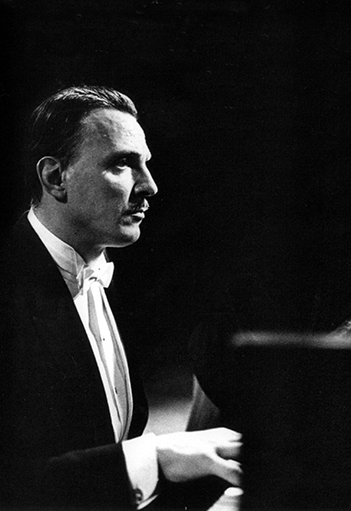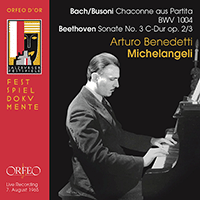Arturo Benedetti Michelangeli
Arturo Benedetti Michelangeli began to study the violin at the age of three, taking lessons at the Venturi Musical Institute in Brescia at the age of four. Around the age of ten he began piano studies at the Milan Conservatory with Giovanni Anfossi and graduated with a diploma in piano at the age of thirteen. Apparently, Michelangeli had no more teachers from that point, but the lack of certainty may be due to his tendency to shroud his life with an aura of mystery and confusion. During his teenage years he studied medicine to placate a father who did not want him to take music as a career, but Michelangeli returned to music and by the age of nineteen was of a high enough standard to win the first International Piano Competition in Geneva. The unanimous jury included Alfred Cortot and Ignacy Paderewski. For the following few years Michelangeli taught at the Martini Conservatory in Bologna and gave concerts. In 1940 he made a sensational debut in Rome where he displayed an extraordinary technique and musical insight.
The outbreak of World War II interrupted Michelangeli’s career just as it had begun. He joined the Italian airforce, but as soon as the war was over, he returned to the concert platform. His first appearance in London was with the London Symphony Orchestra at the Royal Albert Hall. He played Liszt’s Piano Concerto No. 1 in E flat and César Franck’s Variations Symphoniques. Surprisingly, The Times critic was not enthusiastic and found the Franck to be a ‘rather ordinary and not always accurate performance’. However the critic wrote that Michelangeli was ‘…possessed of great power combined with an unusual clarity’ when reviewing the Liszt concerto. Clarity is something often referred to in Michelangeli performances, and this critic also noticed that his tone was ‘…consistently beautiful, and he commands an exceptional legato, which did something to give distinction to Franck’s Variations.’
Michelangeli first toured the United States in 1948, making his orchestral debut at Carnegie Hall in November. He played Schumann’s Piano Concerto in A minor Op. 54 with the New York Philharmonic and Dimitri Mitropoulos and made his solo debut at Carnegie Hall in January 1949. He then had a career of teaching and performing, and during the 1950s spent more time teaching. By 1957, on his return to London, he was already being described as ‘the distinguished young pianist from Italy’.
Michelangeli had built a reputation as much on the frequency of his cancellation of concerts as on his pianism. He never enjoyed performing and would only give a concert if everything was exactly to his liking, and this caused many concerts to be cancelled. Everything he did at the keyboard was weighed and calculated to the last detail, and it was this fear of taking risks that led one pianist to call him ‘the Great Mortician’. However, when he did play in London, the review columns were headed ‘Mr Michelangeli’s Flawless Frigidity’, ‘Mr Michelangeli’s Mastery’, ‘Aristocrat among Virtuosi’ and ‘Aristocratic Poise in Chopin playing’. A 1973 article headed ‘The elusive maestro plays at last’ noted that since he won the Geneva Competition in 1939 his London appearances could be counted on one’s fingers, and that the last three announced had all been cancelled, the last because his piano had been exposed to the elements at Hamburg docks. The article fuelled the Michelangeli myth and mystique by stating that he was said to be descended from St Francis of Assisi and had spent a year in a Franciscan monastery, and by repeating the fact that he was a pilot, racing car driver and skier, that he could build a grand piano and had his own recording studio.
After his London appearances in the late 1950s Michelangeli toured South America and the Soviet Union, and in 1965 toured in Japan. The following year he toured extensively in America, his first visit in fifteen years. In 1973 Michelangeli began teaching at a summer school at Villa Schifanoia near Florence, and in 1980 he visited Japan again but played only one of his five scheduled concerts. In 1988 he had a serious heart attack during a concert in Bordeaux, but continued his performing career until shortly before his death.
Michelangeli’s early recordings were made for HMV in Milan from 1939 to 1942. Amongst works by Grieg, Albéniz, Granados and Mompou, some excellent Scarlatti sonatas stand out, as does the Piano Sonata in C major Op. 2 No. 3 by Beethoven. During the early 1940s he also recorded the Grieg and Schumann Piano Concertos and Bach’s Italian Concerto BWV 971 for Telefunken, amongst other short works.
In 1948 whilst in London he recorded Brahms’s Variations on a theme of Paganini Op. 35, a recording that was to put him firmly on the map of young European pianists. During the 1950s some Mozart piano concertos appeared on the EMI label but it was the 1957 recordings of Ravel’s Piano Concerto in G major and Rachmaninov’s Piano Concerto No. 4 in G minor Op. 40 that received critical acclaim that continues to this day. Michelangeli’s view of Rachmaninov is fascinating. Never wanting to present himself, but only the composer, he gives a performance that is somewhat aloof and distant as regards emotion and passion; but technically, this is a stupendous recording. A few more recordings were issued by EMI in 1975, but these discs, recorded in Switzerland, are hampered by an unpleasant piano tone.
Michelangeli recorded for Deutsche Grammophon between 1971 and 1989, including four Mozart concertos with the North German Radio Symphony Orchestra and Cord Garben, and three Beethoven concertos with the Vienna Symphony Orchestra and Carlo Maria Giulini, the latter of which are taken from live television broadcasts. Michelangeli’s Mozart and Beethoven recordings have received adverse criticism, his Mozart being described as ‘mannered and fussy’ and it can be safely said that he was more successful in other areas of the repertoire. From 1971 comes a Chopin recital and Beethoven’s Piano Sonata in E flat Op. 7. In Chopin his rubato can sound calculated and unspontaneous. Ten years later Michelangeli recorded an interesting disc of Schubert and Brahms’s Ballades Op. 10 on a piano ‘more than sixty years old’. Deutsche Grammophon also licensed a BBC broadcast from 1957 of a Schumann recital containing dramatic performances of Carnaval Op. 9 and Faschingsschwank aus Wien Op. 26. The remainder of the recordings are of Debussy: the Children’s Corner Suite, the complete Préludes and Images. With Reflets dans l’eau from Images, Michelangeli’s reflections are of very bright sunlight on the water; most of his Debussy playing has backbone and is not ethereal or positively Impressionistic.
With an artist as unpredictable and fascinating as Michelangeli there are many recordings of live performances. Some of the earliest come from 1939 including an exhilarating performance of Liszt’s Piano Concerto No. 1 in E flat with the Radio Suisse Romande Orchestra and Ernest Ansermet. A fifteen-disc set of live performances from 1939 to 1990 was issued by Aura in 2000 whilst Memoria issued his last performance from Hamburg on 7 May 1993 when he played a recital of Debussy.
One of the best of the live recordings is a BBC broadcast from June 1965 where Michelangeli played Grieg’s Piano Concerto in A minor Op. 16 in London with the New Philharmonia Orchestra and Rafael Frühbeck de Burgos. This commanding performance has been released by BBC Legends, coupled with Book 1 of Debussy’s préludes recorded in London in April 1982. David Fanning in The Gramophone magazine ended an ecstatic review by writing, ‘This is a performance that entirely merits the hysterical cheers that greet it. I see no point in listing any comparisons.’ However, perhaps the best idea of Michelangeli live is found in a Testament issue of a 1957 London recital which was recorded by EMI but never issued until 1996. As a bonus, a sound check and rehearsal are included where perfectionist Michelangeli can be heard trying the piano. As he got older, Michelangeli reduced his repertoire, and this recital was of familiar works that he often played. Selections from Debussy’s Images are more sharply defined than in the studio recording, and they certainly contain more of a sense of inspiration. In fact, Michelangeli was at the height of his powers for this concert and it is one of the best representations of him on disc as well as some of the most astonishing piano playing recorded live before an audience. The Chopin Ballade No. 1 in G minor Op. 23 is given a stunning performance, but the speed and rhythmic accuracy of the closing presto section somehow strip the music of its dramatic power.
Michelangeli was one of the great pianists of the twentieth century, and his art will undoubtedly continue to have its faithful followers as well as its detractors.
© Naxos Rights International Ltd. — Jonathan Summers (A–Z of Pianists, Naxos 8.558107–10).
In Retrospect – Obsessive perfection (International Piano Magazine feature)

















